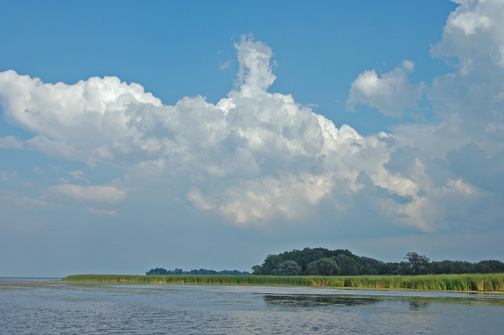Any hybrid can become fairly dominant – or extremely dominant in a lot of wetlands – especially where there are excess nutrients like nitrogen and phosphorus
Researchers who work in wetlands in Michigan are taking a new approach to invasive plants. Instead of removing plants like phragmites and switchgrass, they’re harvesting them. They say these plants are a threat to biodiversity, but they can benefit farmers and even power homes.
Scientists are working in the middle of the Shiawassee National Wildlife Refuge. The refuge is massive, with 10,000 acres of marshes and bogs, forest and farmland. Everywhere you look, there’s a hawk or a herring. Bushes rustle with rodents, and the air is filled with mosquitos and a thick humidity. To put the size in perspective, Manhattan is roughly 15,000 acres, but rather than city chaos, Shiawassee is filled with the sights and sounds of wilderness.
Brendan Carson is one of the lead researchers from the University of Loyola Chicago. Carson and Eric Dunton, wildlife biologist at the Shiawassee refuge, are working on a project centered around invasive cattails.
“The hybrid’s called Typha x glauca,” says Carson. “And the hybrid can become fairly dominant – or extremely dominant in a lot of wetlands – especially where there are excess nutrients like nitrogen and phosphorus.”
The abundance of these cattails occupies space, which ultimately means less room for native biodiversity, and without plant variety, the wetland suffers. The system loses its ability to filter nutrients, and all wildlife – from fish to migratory birds – are affected.
Carson and his colleagues are physically collecting the cattails. Their goal is to deal with invasive species, and address pollution at the same time: a key part of what makes this research so innovative.
Collecting cattails
Rummaging through cattails that stretch well over our heads, the bright red roof of the harvester pushes forward, spitting out cattails as it moves. The machine looks a lot like one of the tiny snowplows that clears the sidewalks, but built on tank treads rather than wheels. It’s specially made for projects where low environmental impact is crucial and with its weight so evenly dispersed, it seems to glide over the marshland, consuming every cattail in its path.
This method of eradication removes the invasive plants from the wetland, while also removing the unwanted nutrients they’ve absorbed.
“Anytime throughout the growing season when the cattail has gotten to the point where it’s a mature plant, it’s taking nutrients through its roots,” says Carson. “It’s taking them out of the soil and the sediment, and incorporating them into growing tissue. So as long as you can remove that tissue while it’s still green, you’re going to be removing quite a bit of nitrogen and phosphorus.” Once these nutrients have been harvested, they’re then put to good use.
Working with local farmers, the harvested cattails are shredded and applied directly to crop fields where the biomass breaks down, providing organic material, as well as recycled chemical fertilizer. The repurposing of these fertilizers can help farmers to reduce their need for additional fertilizers in future years, resulting in lower operating costs, and less environmental impact. The invasive plants may have other economic uses as well.
Greg Zimmerman, a professor at Lake Superior State University, has started using invasive biomass to make fuel pellets. They can be used in pellet stoves, which are similar to wood burning stoves, as a clean alternative heat source. At the University of Wisconsin-Oshkosh, Brian Langolf is using a mechanical digester, which breaks down the material at an accelerated rate. When the invasive biomass is paired with food, or other organics, it turns into a rich compost, and the methane released during the process can be converted to electricity. Langlof says they’re currently producing “roughly the capacity to produce up to 10 percent of our university’s power consumption equivalent, or roughly 220 average American homes year-round [that] we can provide heat and power to.” The economic opportunities on the horizon look promising, but the true potential is still unknown.
Working with local farmers, the harvested cattails are shredded and applied directly to crop fields where the biomass breaks down, providing organic material, as well as recycled chemical fertilizer. The repurposing of these fertilizers can help farmers to reduce their need for additional fertilizers in future years, resulting in lower operating costs, and less environmental impact. The invasive plants may have other economic uses as well.
Greg Zimmerman, a professor at Lake Superior State University, has started using invasive biomass to make fuel pellets. They can be used in pellet stoves, which are similar to wood burning stoves, as a clean alternative heat source. At the University of Wisconsin-Oshkosh, Brian Langolf is using a mechanical digester, which breaks down the material at an accelerated rate. When the invasive biomass is paired with food, or other organics, it turns into a rich compost, and the methane released during the process can be converted to electricity. Langlof says they’re currently producing “roughly the capacity to produce up to 10 percent of our university’s power consumption equivalent, or roughly 220 average American homes year-round [that] we can provide heat and power to.” The economic opportunities on the horizon look promising, but the true potential is still unknown.
Although energy rates in the United States remain unfavorable to alternative sources, other countries have already begun to implement similar methods.
http://interlochenpublicradio.org/post/new-research-shows-invasive-plants-can-feed-farms-power-homeshttp://interlochenpublicradio.org/post/new-research-shows-invasive-plants-can-feed-farms-power-homes


